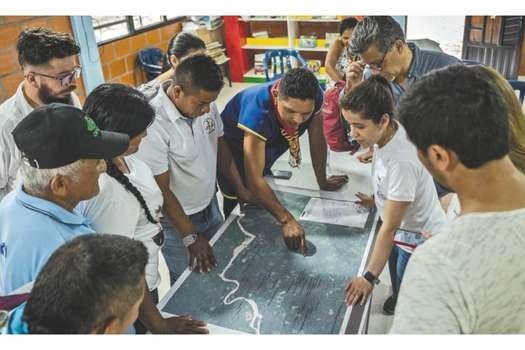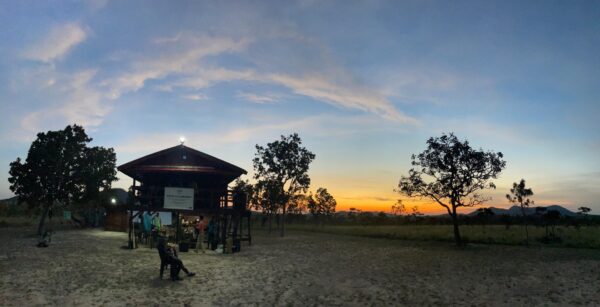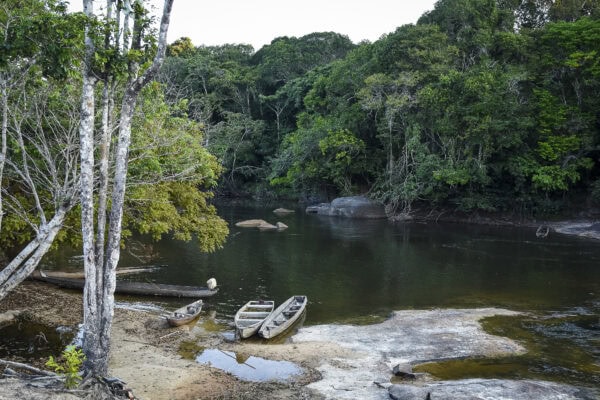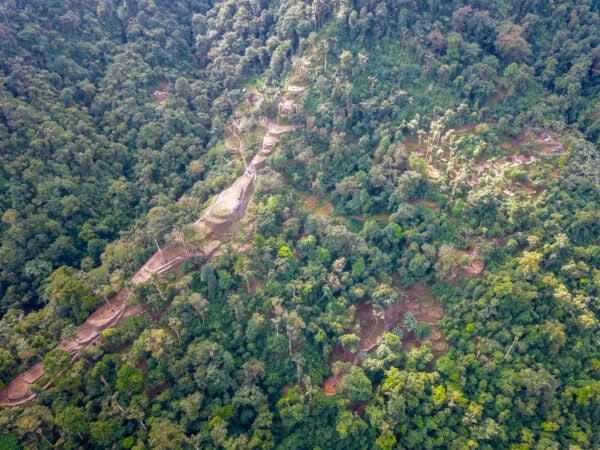July 30, 2023
By María Paula Lizarazo
For the first time in a century, the Agustín Codazzi Institute has decided to generate a map in the Cofán language. To achieve this, they partnered with the communities and their elders, who helped locate their sacred places. It represents the seed of a process to rescue cultures that are at risk of disappearing.

When examining a map of any Colombian territory, it is difficult to detect any point that has been named with an indigenous language. Most are places named in Spanish, despite the fact that many were—and are—inhabited by different peoples. How can this begin to be changed? What is the path for these languages to appear in the cartography of Colombia?
With some of these questions in mind, researchers from the Agustín Codazzi Geographic Institute (IGAC), the entity in charge of producing Colombia’s official maps for a century, began a process of generating toponymies—as the names of places are called—in indigenous languages. It is the first time that IGAC is carrying out this type of effort.
The project arose in 2022, when the institute began a process to strengthen its cartography. Because one of the regions they sought to pay more attention to was the Amazon, they partnered with the NGO the Amazon Conservation Team (ACT), which has carried out participatory mapping work in the region. Although at first it was a purely technical issue, says Daniel Ojeda, a member of IGAC’s Geographic Information Management Department, after discussions, the idea was born.
They decided to work with the Cofán people, located in the Guamuez Valley, on the Colombian border with Ecuador in Putumayo. According to the National Indigenous Organization of Colombia (ONIC), around 1,200 Cofan live in 11 communities on the banks of the Guamuez River and the San Miguel River, tributaries of the Putumayo River.
“One of the main criteria met is that the Cofán language is in danger of extinction,” says Ojeda. It is one of the 65 indigenous languages that survive in the country and, according to Colombia’s Ministry of Culture, it is spoken by just over 600 people. Ojeda notes that this was another reason that they chose to work with this community. “It is a language that the young people do not use; most speak Spanish.”
The IGAC team made the first contacts with the Cofan authorities, and the authorities provided feedback on the concept. “Not only could we now record the name of a river or of a stream of theirs, but we were also interested in being told this in their language, and thus we included a differential ethnic approach, something that does not have many precedents, much less from a technical institute such as ours,” says Ojeda.
At the start of the process, a team from IGAC and ACT traveled to the Guamuez Valley, together with the Cofan, to identify the coordinates of 40 sacred places around the Guamuez River. In addition to locating the sites and recording the names in the Cofan language, they collected information on the history of the sacred sites and the basis for other places of special symbolism, such as the “house of yage” and the “house of the boa”. They also had a team in charge of collecting audiovisual inputs. The information will be published on a website provided by IGAC.
“You will see the river, for example, and the rainforest territories. Another layer will be the 40 sacred places; when you click, the phonetics will appear, and you will see a video of the traditional authority speaking to us. It will be a very interactive platform,” explains Ojeda.
One of the key aspects of this first pilot was the participation of a linguist with an ethnic focus from the Institute as well as a Cofán teacher and translator from Ecuador. Linda García, an ACT coordinator, says that through this initiative, it became evident how “weak the language is in some communities. The contrast was striking when looking at the Cofan in Ecuador and the Cofan we work with here. The community members began to become aware that they are Cofan, but they don’t speak the language.”
The teacher’s job, in García’s words, was “to refresh the memory of the elders and children.” “The translation exercise was not so simple,” she continued, “Because, although they have a living language, the community realized that certain things needed to be reinforced.”
The sociologist Daniel Aristizábal, of ACT, adds that with exercises like the one in this pilot, “one begins to show the reason for the names of many places, place that may even have another name in another indigenous language, or from a previous group that lived there. Then, immediately, a discussion about the history and names opens up.”

In addition, per García, the fact that these initiatives for the preservation of indigenous languages are linked to technical matters, such as those that IGAC works on, contributes “to recognition and claim of rights.” In her opinion, “through the maps, which reflect the reality of the territories of a country, a name and importance begins to be given to indigenous history.”
She continues that “naming things the way they should be named, in this case through the Cofán language, makes people feel recognized. It is important to them their language stays alive, and likewise that it will be possible to preserve their culture.”
Aristizábal agrees on this point. “What is not named does not exist”, he says, “and language generates realities. What has been very interesting is that for 500 years, place names have been imposed by colonial legions, and this grants power over territory. By placing indigenous names on maps, you begin to generate recognition of the place, of its appropriation, and the indigenous claim and legacy, which is also symbolic.”
According to García, for this type of project to occur in a more systematic way in Colombia, the participation of the institutional framework is crucial, as in this case that of IGAC. She also considers it important that there be a synergy, for example, “with the Ministries of Culture and Education, so that these issues are promoted, since they teach us history, emphasizing the Spanish Conquest, but also going further—drawing attention to the peoples that survived, and emphasizing the importance of their ancestral legacy, which is emphasized only at very specific moments.”
Some efforts have already been made in the country to preserve indigenous languages, for example the 2010 Native Languages Law, or initiatives such as the Anthologies of Indigenous Literatures, published by the Ministry of Culture.
Ojeda explains that the idea is for IGAC to “continue generating this type of project, for which we are in the process of selecting new territories in order to develop it.”
An expedition that he has on the list is one through Sierra Nevada de Santa Marta and the sacred sites of the Linea Negra (Black Line) of the Kogui, Arhuaco, Wiwa and Kankuamo indigenous peoples. “We don’t know if there will be 40 places, if it will be 100, or if it will be two, but the approach is already more structured. And I think it is very valuable that it is no longer only seen from the cartographic point of view with GPS surveys, but also to capture that which each of those points denotes and connotes, and to be able to document this.” They also plan to work with other communities that have their own language, such as San Basilio de Palenque and San Andrés.
In addition, he considers it essential to incorporate a “differential ethnic approach in the work of the entities.” He says that the toponymy work “recognizes a debt that is owed in these types of issues.” Aristizábal sees another important point of these IGAC expeditions: that Colombia “is a nation that for 500 years has been colonialist, and through this, it is acknowledging a previous legacy. This can also be useful for the recognition of indigenous territories and the expansion of reserves.”
*This article is published thanks to a partnership between El Espectador and InfoAmazonia, with the support of the Amazon Conservation Team.
Media Relations
For press release inquiries, please contact us at info@amazonteam.org.
Related Articles
Share this post
Bring awareness to our projects and mission by sharing this post with your friends.




